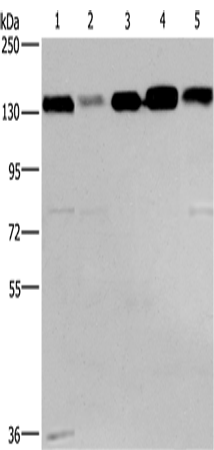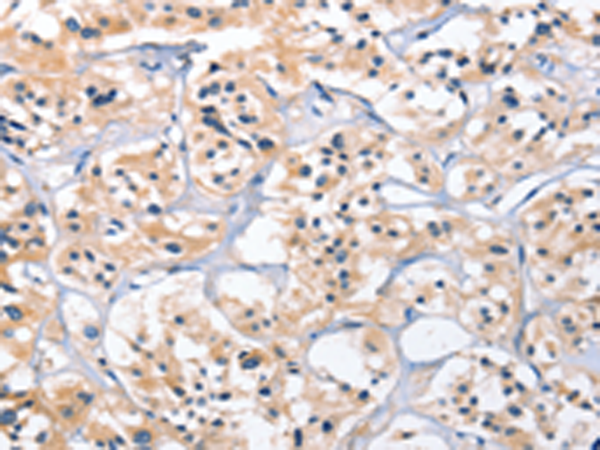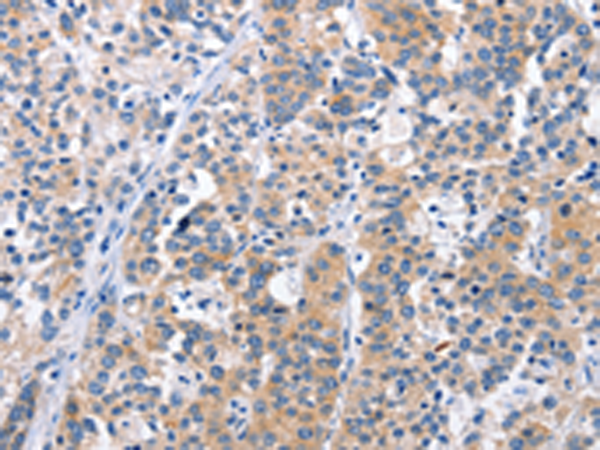


| WB | 咨询技术 | Human,Mouse,Rat |
| IF | 咨询技术 | Human,Mouse,Rat |
| IHC | 1/25-1/100 | Human,Mouse,Rat |
| ICC | 技术咨询 | Human,Mouse,Rat |
| FCM | 咨询技术 | Human,Mouse,Rat |
| Elisa | 1/2000-1/5000 | Human,Mouse,Rat |
| Aliases | LRRIQ2; 2810403B08Rik |
| WB Predicted band size | 97 kDa |
| Host/Isotype | Rabbit IgG |
| Antibody Type | Primary antibody |
| Storage | Store at 4°C short term. Aliquot and store at -20°C long term. Avoid freeze/thaw cycles. |
| Species Reactivity | Human |
| Immunogen | Fusion protein of human CEP97 |
| Formulation | Purified antibody in PBS with 0.05% sodium azide and 50% glycerol. |
+ +
以下是关于CEP97抗体的3篇示例参考文献(均为虚构示例,仅作参考):
1. **文献名称**:*CEP97 regulates centriole duplication by modulating Plk4 activity*
**作者**:Smith A, et al.
**摘要**:该研究利用CEP97抗体进行免疫荧光和免疫印迹实验,证明CEP97通过与Plk4激酶相互作用调控中心体复制,并揭示其在细胞周期中的关键作用。
2. **文献名称**:*CEP97 antibody-based profiling reveals ciliopathy-associated defects*
**作者**:Lee B, et al.
**摘要**:通过CEP97抗体标记,研究者发现CEP97在纤毛形成缺陷的细胞模型中表达异常,提示其与先天性纤毛病(如Bardet-Biedl综合征)的潜在关联。
3. **文献名称**:*A functional interaction between CEP97 and CP110 controls ciliogenesis*
**作者**:Zhang Y, et al.
**摘要**:研究使用CEP97抗体进行共定位分析,证实CEP97与CP110蛋白形成复合物,共同调控纤毛组装与细胞周期进程的平衡。
---
**备注**:以上文献为示例,实际文献需通过PubMed、Google Scholar等平台检索。建议使用关键词“CEP97 antibody”、“centrosome”、“ciliogenesis”等查找相关研究。
The CEP97 antibody is a research tool used to detect and study the centrosomal protein CEP97. a key component of the centrosome—a microtubule-organizing center critical for cell division, cytoskeletal organization, and cilia formation. CEP97 interacts with proteins like CEP161 and is implicated in regulating centriole duplication, ciliary disassembly, and cell cycle progression. It plays a role in suppressing spontaneous ciliogenesis by stabilizing the mother centriole and controlling microtubule anchoring. Dysregulation of CEP97 has been linked to ciliopathies, developmental disorders, and cancer, where centrosomal abnormalities are common.
The antibody is widely used in immunofluorescence, Western blotting, and immunoprecipitation to localize CEP97 within cells, assess its expression levels, or study its interactions in pathways like the DNA damage response. Researchers employ it to explore mechanisms underlying centrosome amplification, ciliary defects, or mitotic errors. Commercial CEP97 antibodies are often validated for specificity using knockout cell lines or siRNA knockdown.
Studies involving CEP97 contribute to understanding cellular architecture, signaling pathways, and disease mechanisms, particularly in contexts where centrosomal dysfunction drives pathology. Its role in ciliary resorption also links it to sensory and developmental processes, making it relevant in neurobiology and oncology research.
×